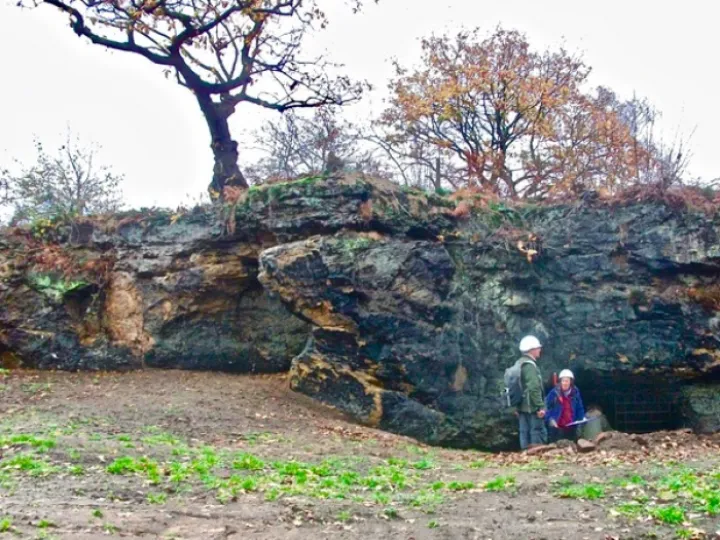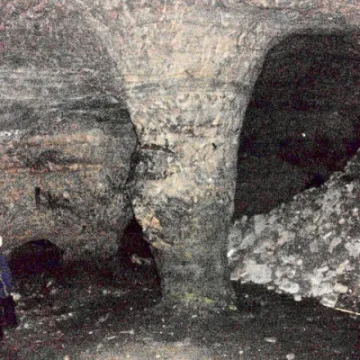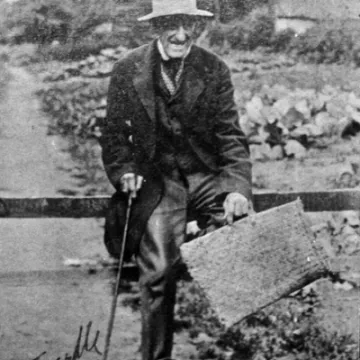The Conker Cave & The Tweedales - Sand-men of Helsby
One of the most remarkable feats of cottage industry to be seen along the entire length of the Sandstone Ridge is the "Conker Cave"(1) at Hill Road North in Helsby. On a small plot of land, once known as "Cobbler's Wife", there is a cavern carved out by hand to extract a particularly fine white sand. This sand had a variety of uses but was probably used in greatest quantity during the eighteenth century for spreading on and scouring cottage floors, a practice that lasted well into the nineteenth century.
Photo 1 – Exterior of the Conker Cave
Today the entrances to the cave are on private land, caged and locked, and the cave is monitored by the Cheshire Bat Group. Quarrying activity once left a large amount of spoil in front. This has been levelled but has resulted in the entrances being partially blocked, giving access down a fairly steep internal slope, over the spoil, into the cave. Once inside, however, the visitor cannot fail to be surprised and impressed by the excavation. The "pillar-and-stall" technique of hand excavation has been employed, resulting in a clover-leaf of rooms, but what sets this cave apart from others on the Ridge is the remarkable height of the ceiling which reaches in places up to six metres. Most sand caves on the Ridge are only as high as a tall man can reach to scrape but here it feels as though an entire hill has been hollowed out. It leaves the overburden very thin in places and threatens some danger of ceiling collapse.
Photo 2 – Interior of the Conker Cave
Indiscriminate mining of sand by local people would probably have been taking place in this area for centuries but the movement towards enclosure resulted in 1797 in this plot being designated as common land, specifically for the extraction of sand. After the General Enclosure Act of 1801, any village, where three-quarters of the landowners agreed, could enclose its plots so that they became the exclusive property of their owners who would then lease them out to private individuals. In the case of this plot the owner was the ubiquitous Marquis of Cholmondeley. The Tithe Commutation Act of 1836 led to maps being produced to resolve boundaries, ownership and valuation, and the local map of 1846 reveals that "Cobbler's Wife" was, by then, leased to a "Charles Tweedale". A neighbouring plot, also owned by Cholmondeley, continued to be described as a "common lot" but, in fact, was leased to John Mountfield, a wealthy farmer.
At the same time, on some land on "The Rock" to the south of Helsby Hill, there was a house and garden owned by the Township of Helsby but enclosed and leased to a "John Jr Tweedale". On this plot there was also a cave known as "The Bear Hole" and this cave, although nowhere near as massive , also shows signs of sand mining(2).
Both Charles and John Tweedale had come from nearby Overton, Frodsham. John had been born there in the late 1790s and Charles, although born in Warrington in 1806, was living there when his oldest sons were baptised in 1827 and 1834. It is likely that the two were either brothers or cousins but the family tree of the Tweedales remains to be fully disentangled. Their move to Helsby (Charles arrived there in the late 1830s) coincides with the Tithe Act and so they may have been among the first to take advantage of the loss of common rights and exploit the sand as a private business.
Both John and Charles may already have had experience in sand-mining as there were extensive sand caves in Overton(3) but it was Charles Tweedale (pronounced and sometimes spelt Tweedle) and his family who really developed the business in Helsby. They lived on their plot in a house called "Cobbler Hall". In the censuses, Charles was described as a "besom manufacturer" but he must surely have taken the lease on "Cobbler's Wife" because of its sand resources. His wife Sarah (Sally) seems to have been a strong and erratic character. They had nine children: Samuel, William (Billy), Richard, Thomas, Charles, Elizabeth, Sally (d.in infancy), Sarah and George.
All of the resident family were probably involved in the labour of extracting the sand from time to time, but it was only Billy who was recorded in the Census of 1851 as a "Dealer in Sand". Among his older siblings, his brother Thomas was living at home, his occupation described as "Out of service", Samuel was living elsewhere in Helsby and their brother Richard was a farm labourer working in Netherton, Frodsham. By 1861 old Charles was retired but Billy continued as a dealer in sand and "rubbing stone"(4) and his younger brother George was described as an agricultural labourer. No-one ever seems to have been recorded as a sand "miner"; only "dealer" or "labourer". Other siblings were in service.
Old Charles died in 1865. His widow, Sally, did not stay long in mourning. An extraordinary encounter was recorded in the Cheshire Observer in 1869 when she was probably 63. It gives us a glimpse of a somewhat turbulent family. Under the headline "Elopement from Helsby" a reporter describes meeting Billy on the road :
"Have ye seen me mother, sir?" the above question was addressed to your correspondent on Wednesday evening last, when passing through the somewhat quiet village of Barrow, by a singular looking individual, who goes by the name of "Billy Tweedale," a notorious sand and rubbing-stone vendor, a native of Helsby. After replying in the negative, I pressed him for particulars, and with a little difficulty succeeded in eliciting the following: that his mother Sally Tweedale, an old woman of some sixty summers, eloped on Monday last with a navvy, who has recently been working in that neighbourhood, taking with her a sum of money. The poor fellow, who seemed to be greatly grieved at his mother's heartless conduct, stated he had visited Runcorn, Weston, Kingsley, and other places, without obtaining any clue to the runaway. – W.H. (Cheshire Observer 13/3/1869).
Billy would have been 42 at this time. He never married and his behaviour suggests some dependency on his mother. It is not clear why the journalist should have described him as "notorious" but delivering sand to all the local cottages would have made him a familiar figure. During his later residence at the workhouse he was defined as an "imbecile". This was a term used to indicate, among other things, limited mental ability. It was not as pejorative a term as it is today and could have just implied vulnerability, so the best we can conclude is that local people would have regarded Billy as a "character".
Life with a navvy may have proven too precarious for Sally as she was home again by the time of the 1871 census. In that year the occupation of both she and Billy was recorded as "carter". Carting the sand was probably something that they had always done but they may now have needed to hire themselves out to deliver other materials. It is interesting to see that Sally was performing that role well into her 60s. Richard had returned to join them as a labourer but the 1870s seem to have seen the end of their business. Floors could now be covered in washable linoleum(5) and the family found itself on hard times.
By the 1881 census, "Cobbler's Wife" had been abandoned. Billy with his mother Sally and his sister Elizabeth were living at the Dutton Workhouse and the rest of the family had dispersed. Both Billy and Elizabeth were registered there as "Imbeciles". Sally died there later that year and Elizabeth there in 1888. Richard, too, was there in 1891 but Billy remained a resident at Dutton in both the 1891 and 1901 censuses. This doesn't mean that he lived there permanently. Whether he was in the workhouse because of ill health or lack of means is not known, but he continued to roam the area and scrape a living from his dwindling trade. While the main demand for sand in quantity had disappeared, it would have still been needed for such tasks as sharpening tools and spreading on the floors of bird-cages.
There is a photograph said to be of Billy taken in 1880. It shows an old man with a broad grin, certainly looking older than his 53 years. He is warmly dressed and alert, with cane and an unusual woven basket with a handle on the long side. Its purpose is not entirely clear but it may have been used for scooping and pouring sand. It is thought that the signature on the photo is unlikely to be in Billy's own hand.
Photo 3 – Billy Tweedle, 1880.
Courtesy of Cheshire Archives and Local Studies, image FDN0246
Billy Tweedale died at the workhouse on 18th December 1901 and was buried in Little Leigh. His younger brother George became a greengrocer and cab proprietor and in 1901 and in 1911 was living in Town Cottages, Bears Hole. This may have been in the same house where his "uncle?" John had lived and it is not impossible that he continued some trading in sand. Nineteenth century grocers dealt in many domestic products and elsewhere on the Ridge, at Beeston for example, the grocers Beresford were also associated with that dying trade(6).
There were sand holes throughout the length of the Sandstone Ridge. Most have disappeared or their original function forgotten. It is rare to find records of actual individuals and their families who depended on this dangerous and low-status industry and, like the poor in any age, they have been largely overlooked by history. Happily, on the Sandstone Ridge, Billy the Helsby Sand-man and his extraordinary cavern are not entirely forgotten.
We are indebted to the research undertaken by local historian, Susan Lorimer, for much of the material in this article. Any further information about the Tweedales or the sand-mining industry on the Ridge would be welcome.
Peter Winn, Trustee
Due to conservation risks and the inherent dangers of underground exploration, the Sandstone Ridge Trust does not support visits to any caves without the permission of the landowners and due attention to safety. We cannot accept responsibility for personal injury should anyone choose to explore caves on the Ridge.
(1)The name is due to the presence of horse-chestnut trees in the area.
(2)Tithe Plot 19. See our article on the Sandstone Ridge Trust's website "Bear Caves on the Ridge" CLICK HERE. Passages from this cave run north and south and further investigation may reveal more extensive mining than is currently visible.
(3)See our article on the Sandstone Ridge Trust's website "Upton's Caves, Frodsham" CLICK HERE.
(4)Also known as hearthstone, the less friable white sandstone could be used for scouring door steps, hearths and windowsills.
(5)Linoleum was invented in England in 1860 and it was being advertised in local newspapers as early as 1865. See Hyde and Glossop Weekly News and North Cheshire Herald 22/4/1865 and Chester Chronicle 29/12/1866.
(6)See our article on the Sandstone Ridge Trust's website "The Beresfords of Beeston" CLICK HERE.

Sandstone Ridge Trust
Registered Company No. 7673603
Registered Charity No. 1144470
info@sandstoneridge.org.uk


